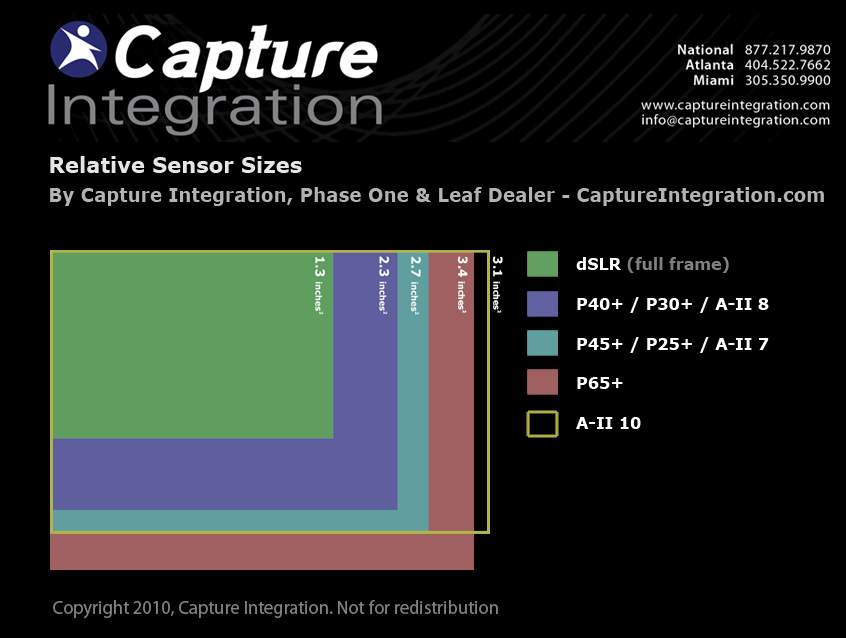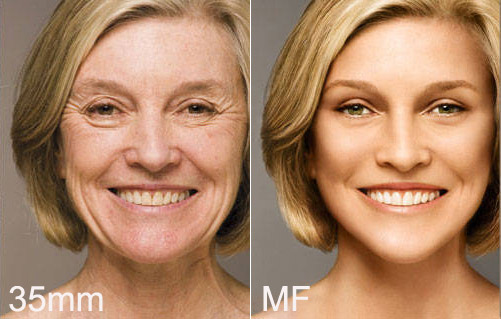Well I'm having a few refreshments at the bar in the Pittsburgh airport so I'll share my thoughts...
In theory - absolutely
There ARE engineering limitations to overcome as you decrease micron size (which you have to do as you increase resolution on the same small sensor). However, I don't think it's impossible to imagine that continue technological development would allow a 4 micron pixel to outperform todays 6 micron pixel (e.g. P65+). However it is an uphill battle technology wise - it is simply MUCH easier to maintain high image quality with larger sensors. A P65+ is MUCH larger than a full frame dSLR. See below:
However there are two very good reasons why I would be shocked to see "in theory" become reality.
1. The "Complete" System
Here is a partial list of a camera system which effect image quality (more or less start-to-finish):
Lens Hood / Flare > Lens coating > lens > aperture/shutter > body's blackness > IR filter > microlenses > AA filter (or lack thereof) > sensor size > sensor pixel type > readout speed > sensor-to-AD-convertor path, A/D convertor > heat sinking / cooling > raw file compression > black calibration > in camera raw data manipulation > characteristic curve > ICC profile > demosaic algorithm > deconvolution algorithm > noise reduction type > up-res or down-res algorithm > sharpening
If Canon/Nikon/Sony wanted to compete IQ wise with digital backs they would have to address most or all of the above issues. It's not a sensor, or a bit depth, or an ADC, or any individual component that makes the difference - it is the complete system.
2. Business Model
IF it was Canon (or Nikon or Sony) business model was to produce a camera which produced the highest image quality regardless of cost or compromise then they could. They are larger companies with more resources than any of the medium format market, and while Phase/Hassy/Leaf/Sinar/Mamiya have very talented and experienced engineers (software/hardware/firmware/optical) and patents on some important technologies, but in the grand scheme of things Canon/Nikon/Sony could roll over them in a heart beat (meaning within a camera generation or two) if they threw their weight behind it. But they haven't so far and my guess is they never* will.
It's like asking Ford to produce a competitor to the Tesla Roadster. It's not their business model - it's not what they do and it's not how they make money.
Put yourself in the shoes of the management of Canon - you have to direct R+D and pricing/value decisions on a new camera. Your CFO informs you that you've made XXX million profit on Point and Shoots, XX million profit on 5DII, and X million profit on the 1Ds III. Your Chief Pro Engineer (made up title) informs you they can change the ADC on the 1Ds IV to a high quality 16 bit A/D convertor but it will cost $XXX per unit in direct manufacturing costs and the efforts will be wasted unless you invest $XX million in R+D on new lens coatings (raising the price of each lens) internal baffling and the results will be mostly seen when using EOS Utility (Canon's proprietary developer) and not in Aperture, Adobe Camera Raw or LightRoom (which 9X% of your users use). OR you could use that R+D to add a slightly faster AF sensor, or a slightly larger LCD which will not improve IQ but which will get a LOT of attention amongst the majority of your customers. Where would you spend your R+D?
As a case study take CMOS vs. CCD. There is no doubt that CMOS is more convienent. It has (at the high-end) better high-ISO performance and allows for both video (e.g. darn good 1080p using a 5DII) and live preview which is, simply put, a GREAT convenience for photographers. However CCD still has the edge right now on color, dynamic range, noise at low ISOs, and tonal transitions / look. If Canon made the 1Ds III a CCD based camera they would have made a modestly better IQ camera but they would have been slaughtered in sales by Nikon's D3X (because of ISO, shooting speed, live preview). See the M9, Pentax 645D, nearly every digital back every made, the R9's digital module, and the Kodak 14n for examples of just how great CCD image quality can be and what kind of companies opt for CCD over CMOS.
And basically every component is like this: there is always a compromise associated with going the route of best image quality. There is no "magic" of medium format - just the natural result of well experienced and hard working companies using larger sensors with lots of R+D for all parts of the system targeted at image quality as the number one priority.
Also the market for very-high-end cameras is pretty broad but shallow and requires a much different approach than the markets Canon/Nikon/Sony currently pursue: fine art shooters, high-end fashion, high-end still-life/product, architecture, landscape, museums (art reproduction), forensics, aerial (both artistic and mapping/technical). Almost all require a very hands-on knowledgable approach - they aren't boxes like a Canon 5DII which you order online and open and use. So to sell a very high-end camera Canon/Sony/Nikon would need to add a new form of distribution world-wide, offer product margins that allow vendors to do more than buy and sell boxes (I'm obviously not allowed to tell you what we make off a Canon sale but suffice it to say that the number of value-added, very knowledgable, very hands-on dealers of Canon that make their money primarily on selling Canon cameras is very low), and add a support structure above and beyond their current "pro" service (NPS and CPS - I'm not aware if Sony has a Pro Service system).
*I'm a very technical guy so "never" in this case means in the foreseeable future which I'd put at around 10-15 years. More than 10-15 years out I can't even begin to guess and whether there will be something that resembles a dSLR or medium format camera. We may all be walking around with cameras embedded in our eyes.
Got to catch my flight now...
I'll leave you with the following thought: an H25 which was released in 2003 still handily beats a 1Ds III or 5D II in every area of image quality (other than moire). It's FAR less convenient (no LCD, only shoots tethered, maxes out at ISO100 for good quality, and only shoots 1 frame every 2 seconds or so) but the image quality is still superior - after 7 years of dSLR development.
Doug Peterson
(e-mail Me)
__________________
Head of Technical Services, Capture Integration
Phase One Partner of the Year
Leaf, Leica, Cambo, Arca Swiss, Canon, Apple, Profoto, Broncolor, Eizo & More
National: 877.217.9870 *| *Cell: 740.707.2183
Newsletter | RSS Feed
Buy Capture One at 10% off

